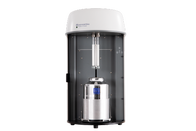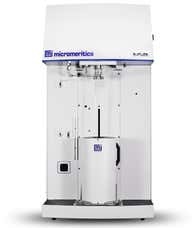
Micromeritics TriStar II Plus
High throughput BET surface area analyzer
Precision BET surface area analysis for superior material performance
BET (Brunauer, Emmett, and Teller) surface area analysis is the most widely used technique for determining the exposed specific surface area of a solid sample on the molecular scale. This method calculates surface area based on the monolayer capacity-- the quantity of gas molecules or atoms that form a single layer on the surface.
Typically, nitrogen gas (N2) is used as the adsorbate due to its strong affinity for solid surfaces. The analysis is usually performed at cryogenic temperatures, where the gas is introduced at low pressures, and the amount adsorbed is measured to determine surface area using the BET method. For materials with low surface area, krypton gas (Kr) is commonly used as an alternative adsorbate. With a lower vapor pressure (2.5 mmHg) compared to N2 (760 mmHg) at 77.3 K, Kr allows for determining more sensitive pressure changes during adsorption, resulting in greater accuracy.
Now, with Malvern Panalytical offering Micromeritics’ industry-leading analyzers, researchers and manufacturers can rely on unparalleled accuracy, efficiency, and reliability to optimize material characterization and product development.

High throughput BET surface area analyzer

High performance gas adsorption
BET (Brunauer, Emmett, and Teller) surface area analysis is the most commonly used technique for measuring the specific surface area of porous and powder materials. It plays a vital role across multiple industries.






Micromeritics TriStar II PlusHigh throughput BET surface area analyzer |

Micromeritics 3FlexHigh performance gas adsorption |
|
|---|---|---|
| Measurement type | ||
| BET surface area | ||
| Porosity | ||
| Chemisorption | ||
| Features | ||
| Sample throughput | 3 samples in parallel | 1–3 samples |
| Micropore analysis | Optional | Yes (high-performance) |
| Multi-gas capability | ||
| Vapor adsorption | ||
| Dynamic chemisorption | ||
| Low surface area sensitivity | Krypton option available | |
| Automation | ||
| Best for | High-throughput BET analysis | Advanced material research & catalyst studies |